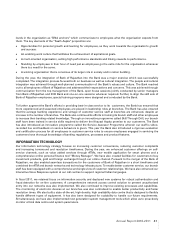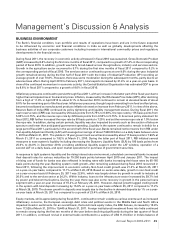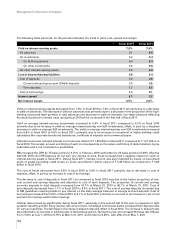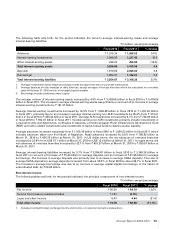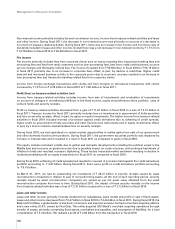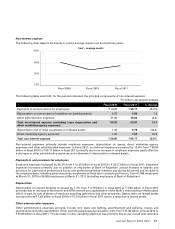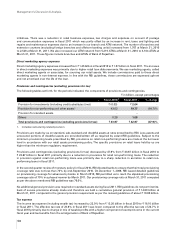ICICI Bank 2011 Annual Report Download - page 51
Download and view the complete annual report
Please find page 51 of the 2011 ICICI Bank annual report below. You can navigate through the pages in the report by either clicking on the pages listed below, or by using the keyword search tool below to find specific information within the annual report.
Management’s Discussion & Analysis
BUSINESS ENVIRONMENT
The Bank’s financial condition, loan portfolio and results of operations have been and are in the future expected
to be influenced by economic and financial conditions in India as well as globally, developments affecting the
business activities of our corporate customers including increase in international commodity prices and regulatory
developments in the financial sector.
During fiscal 2011, the recovery in economic activity witnessed in fiscal 2010 was sustained. Gross Domestic Product
(GDP) increased by 8.6% during the first nine months of fiscal 2011, compared to a growth of 7.4% in the corresponding
period of fiscal 2010. In addition, growth was fairly broad-based across the agriculture, industry and services sectors.
Growth in the agriculture sector recovered to 5.7% during the first nine months of fiscal 2011 compared to 0.2% in
the corresponding period of fiscal 2010. The services sector continued to grow at over 9.0% during the year. Industrial
growth remained strong during the first half of fiscal 2011 with the Index of Industrial Production (IIP) recording an
average growth of over 10.0%. However, there was some moderation during the subsequent months, partly due to an
adverse base effect. During April 2010 to February 2011, total exports increased by 31.4% on a year-on-year basis. In
view of the continued momentum in economic activity, the Central Statistical Organisation has estimated GDP to grow
by 8.6% in fiscal 2011 compared to a growth of 8.0% in fiscal 2010.
Inflationary pressures continued to persist through fiscal 2011, with an increase in the latter part of the fiscal year due to
higher than anticipated rise in food and oil prices. Inflation, measured by the Wholesale Price Index (WPI), after declining
from a high of 11.0% in April 2010 to about 8.1% in November 2010 continued to remain at elevated levels of about
8.0% for the remaining part of the fiscal year. Inflationary pressures, though largely emanating from food and fuel prices,
became broad based as manufactured products inflation showed an increase from February 2011. In view of the above,
Reserve Bank of India (RBI) continued its policy tightening and liquidity management stance. During fiscal 2011, the
cash reserve ratio (CRR) was increased by 25 basis points from 5.75% to 6.00%, the repo rate by 175 basis points from
5.00% to 6.75%, and the reverse repo rate by 225 basis points from 3.50% to 5.75%. In its annual policy statement for
fiscal 2012, RBI further increased the repo rate by 50 basis points to 7.25% and set the reverse repo rate at 1.0% below
the repo rate. In addition, during certain periods, liquidity was also impacted by events such as the auction of telecom
spectrum and lower than anticipated government spending. Liquidity in the system continued to remain in deficit for a
large part of fiscal 2011, particularly in the second half of the fiscal year. Banks remained net borrowers from RBI under
the Liquidity Adjustment Facility (LAF) with average borrowings of about ` 640.00 billion on a daily basis between June
1, 2010 and March 31, 2011. The yields on 10 year government securities increased by about 17 basis points to 7.99% at
March 31, 2011 as compared to 7.82% at March 31, 2010. During the latter part of fiscal 2011, RBI initiated several
measures to ease systemic liquidity including decreasing the Statutory Liquidity Ratio (SLR) by 100 basis points from
25.0% to 24.0% in December 2010, providing additional liquidity support under the LAF window, operation of a
second LAF on a daily basis, and open market operations for purchase of government securities.
In response to tight systemic liquidity and the rising interest rate environment, scheduled commercial banks increased
their deposit rates for various maturities by 75-250 basis points between April 2010 and January 2011. The impact
of rising cost of funds for banks was also reflected in lending rates with banks increasing their base rates by 95-165
basis points during the year. Banking system credit growth, after remaining subdued during fiscal 2010 recovered in
fiscal 2011, following the improvement in economic activity. Non-food credit growth was 21.2% at March 25, 2011
on a year-on-year basis, compared to 17.1% at March 26, 2010. Based on sector-wise data, growth in non-food credit
on a year-on-year basis till February 25, 2011 was 22.8%, which was largely driven by growth in credit to industry at
26.5% and to the services sector at 24.2%. Within industry, loans to the infrastructure sector increased by 39.7% led
by power and telecommunications. During the year, there was also some recovery in growth in the personal loans
segment with a year-on-year increase of 16.2% at February 25, 2011. However, deposit growth lagged credit growth
in the system with total deposits increasing by 15.8% on a year-on-year basis at March 25, 2011 compared to 17.2%
at March 26, 2010. The slower growth in deposits was largely due to the decline in demand deposits by 1% on a year-
on-year basis at March 25, 2011 as compared to a growth of 23.4% at March 26, 2010.
Equity markets, while appreciating during fiscal 2011, continued to remain volatile as various events such as increased
inflationary concerns, the European sovereign debt crisis and political events in the Middle East and North Africa
impacted investor sentiments. On an overall basis, the benchmark equity index, the BSE Sensex, increased by 10.9%
from 17,528 at March 31, 2010 to 19,445 at March 31, 2011. Foreign institutional investment flows into India continued
to remain strong during the first ten months of the year before declining significantly during the last quarter of fiscal
2011. In addition, continued revival in external trade contributed to a surplus of US$ 11.0 billion in India’s balance of
Annual Report 2010-2011 49




